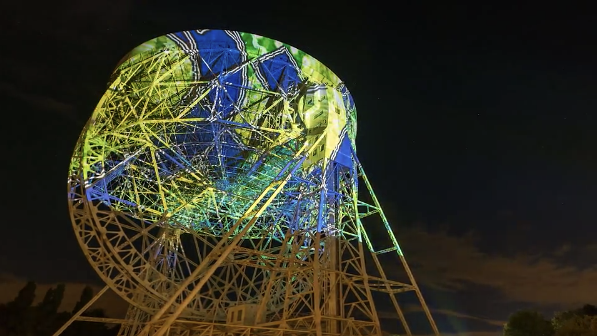I just found this short film I made of Brian Eno’s installation on the Lovell Telescope during bluedot festival in July 2016. It shows his beautiful projection which wrapped the Telescope in generative abstract colour patterns on each of the three nights of the festival.
The telescope was parked for maintenance pointing to the zenith. Three projectors (operated by Pod Bluman’s team) were used to wrap light around the complex structure supporting the 76-metre diameter bowl of the telescope. The patterns only gradually evolved – often seeming static at first glance. But look away and then back again and the appearance was radically different. This short clip is speeded up by a factor 8 to show the changes more clearly.
Here’s a much longer, far more professionally produced, and beautiful timelapse of the installation from Kris Williams.


One response to “Eno Paints Light on the Lovell Telescope”
I am older than the radio telescope but have had less upgrades.
I propose a new application for Jodrell Bank saving billions$ compared to getting information from local stellar systems.any other way
I am not an academic but an engineer and my ideas can be found incorporated in subsea fibre-optics, health monitors and some of the Apollo bits left on the moon.
I believe there is a way to use a natural phenomena to get a radar echoes from local stellar targets
Fast Radio Bursts are brief (just a few milliseconds) and so weak that they are only detected by radio telescope pointing in the right direction where they were originally regarded as a nuisance until their nature became apparent.
A characteristic of FRBs is that they are chirped, that is the pulse is swept in frequency commencing at approvimately1400 Mhz
The use of a chirp was adopted by evolution by various species as a means of increasing the sensitivity and range of their acoustic location system
Think of “Fast Radio Bursts” as natures primary radar pulses, the extreme distance of the FRB origin means that
the same FRB will arrive at all of our local nearby star systems at the same time.
Inevitably there will be reflected echoes of the FRB from Proxima system.
The difficulty will be extracting the vanishingly small echo from cosmic background noise.
Fortunately the FRB is a previously measured dispersed RF pulse so there will be signal gain available from signal processing these special circumstances may be sufficient to make extraction of the reflected signal possible. Similarly a great deal of gain and signal to noise improvement will be available from diversity reception from combining information from the many radio telescopes currently used for the SETI search that could , for a brief period be pointed at The Proxima system
The original FRB detection depended on chance, but now we have knowledge of the timing
and the dispersion envelope; this information can be used for synchronous
detection and compression of the echo, in addition we will now know the direction of the potential reflecting body and the time of the anticipated echo arrival . Successful reception of such an echo and comparison of the original FRB and its echo will provide information on the rotation and atmosphere of the reflecting bodies.
The time of arrival and direction should enable discrimination of the various sub echoes from the target system.